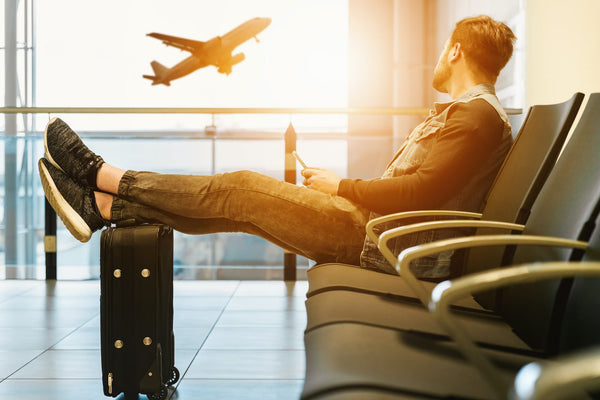When you’re traveling, one of the hardest parts of the journey is figuring out how you’ll bring all your necessities along with you; and most notably, the bigger stuff. If you’re dragging a desktop around, or even a laptop that you need to use two screens with, learning how to travel with a monitor is going to be one of those hardships. They’re fragile, relatively large, and expensive enough to warrant extra care and attention when transporting.
So, we’re going to go over a few tips on how to travel with a computer monitor to help you keep from having to sacrifice.

How to Travel with a Monitor on a Plane?
This is probably the most difficult way to travel with a monitor, but it’s not impossible, and you don’t need to leave your fancy monitor at home just to get on your flight.
Traveling with Your Monitor as Checked Luggage
This method has its pros and cons. Namely, your monitor will go off into a cargo hold instead of taking up valuable room in your carry-on luggage. That also means it’s at the mercy of airport staff instead of you personally looking after it.
That’s not a problem, but you should take a few precautions before you check that monitor in and hope for the best.
First, always check the weight and size requirements of checked baggage at your airport of choice. Depending on the size, you may have to go with this method; there might be special steps that have to be taken, and more.
Now, take the time to package the monitor properly. You can do this by wrapping it in foam or bubble wrap and placing it in a hardshell suitcase. This will hopefully prevent scratches or unfortunate breaks, and the shell will keep other people’s baggage from crushing it.
Once you’ve protected it as much as possible, label the suitcase with a “Fragile” sticker to make any overzealous staff members think twice about tossing it around.
Finally, it’s highly recommended to get renter’s insurance in case something does happen. Even if you’re at the most cautious airport globally, your package will still be flying around in a cargo hold at 32,000 feet. Anything can happen.

Traveling with Your Monitor as a Carry On
Choosing the carry-on route will give you better peace of mind as your monitor will be right above your head the entire trip. However, it can be a bit more of a hassle.
First and foremost, you must check the size of your monitor against the size of the overhead compartment. If it doesn’t fit, you’ll have to go with the checked baggage method. If it l fits, you should wrap the monitor as described earlier to prevent it from being damaged.
However, this is where it gets a bit different. Airport security has increased dramatically over the last two decades, and it’s highly unlikely that you will be able to just waltz onto the plane with a strangely wrapped electronic device with no questions asked. Instead, you'll probably be forced to remove everything you wrapped around it and any case you may have stored it in for a thorough examination. It's best to prepare for this by not wrapping it in a way that makes it difficult to unwrap and rewrap quickly, and you should probably get to the gate a little earlier than you normally would leave time for this, admittedly annoying, process.

Traveling with a Portable Monitor
If you’re lucky enough to have purchased a highly compact and portable monitor, the entire process is a lot simpler for you. Full-sized monitors are simply too bulky and heavy, making them more prone to damage and almost always forcing them into the checked baggage category.
In comparison, a portable monitor is a lot easier to handle. The small size of a portable monitor makes packing it into your suitcase an easy task, and you should be able to fit it in any overhead compartment with ease. This reduces the risk of damage, keeps you in charge of how it’s being handled, and just gives you better peace of mind since it’s right above you.
Then, you also get the normal benefits of a portable laptop monitor. First and foremost, it just attaches to your laptop and slides out when it's needed. This means that you can keep your extra monitor –and all the multi-tasking abilities it grants you- with you. You don’t have to worry about going without your second monitor throughout your trip.
This also comes with the benefit of not adding a lot of weight to your luggage, and you don’t have to wrap it separately. You can keep it attached to your laptop and simply store it alongside your laptop, or add it to another carry-on container that is padded enough to ensure its safety. You don’t need a special, individualized storage system for it.

Finally, you’re not going to get as much attention. Yes, you’ll probably still have to let the TSA or similar service see the monitor before boarding the plane, but you won’t get nearly as much grief as you would if you were packing a standard 24-inch or even a massive 32-inch standalone monitor.
If you want to learn a little more about how to travel with a computer monitor that’s a bit more portable, check out this guide.
Of course, you could also take the time to dive right in and see for yourself. At Mobile Pixels, we have released the top portable laptop monitors to let you take multitasking and highly-efficient work on the go.
Make traveling as easy and productive as possible with the Duex series from Mobile Pixels!
Leave a comment
All comments are moderated before being published.
This site is protected by hCaptcha and the hCaptcha Privacy Policy and Terms of Service apply.